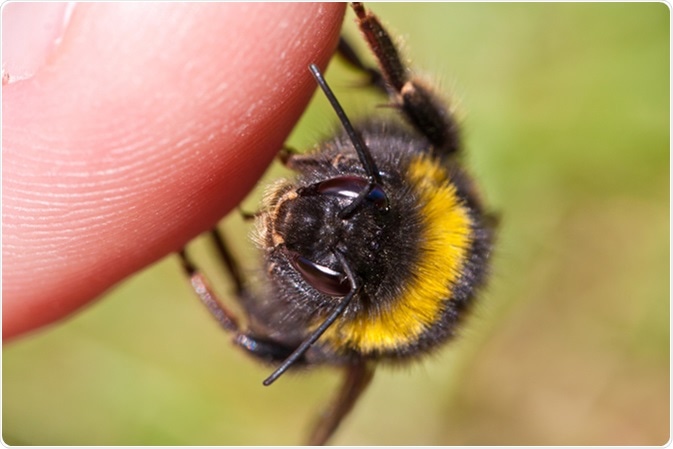Bee sting is a type of injury caused by bee venom that induces toxic reactions at the site of sting. It is manifested as pain, redness, and swelling of the affected area. These symptoms generally subside within a day. However, if a person is allergic to bee venom or gets multiple bee stings, a severe allergic reaction (anaphylaxis) may occur, which is often life-threatening.

Image Credit: PhilMacDPhoto / Shutterstock
Typical signs and symptoms of such reactions include:
- Breathing difficulties
- Swelling of the throat and tongue
- Feeble and rapid heart rate
- Dizziness
- Nausea and vomiting
- Diarrhea
- Loss of consciousness
- Fever and headache
- Convulsion
If a person is suspected to have bee venom allergy, a medical examination is indicated to confirm it. Laboratory tests that are routinely used to diagnose bee venom allergy include:
- Skin prick test – also called skin puncture test, is used to examine immediate allergic reactions to suspected allergens.
- Intradermal test – is used to examine the sensitivity of a person to suspected allergens. It involves injecting a small amount of suspected allergen into the skin and examining if there is any allergic reaction.
- Serum specific antibody measurement – involves testing blood samples for either total immunoglobulin E or allergen-specific immunoglobulin E. Immunoglobulin E is an antibody involved in classic allergic reactions. The level of this antibody in the blood directly measures the intensity of allergic reaction to a specific allergen.
How to Treat a Bee Sting
Treating a Bee Sting
A bee sting that does not induce an allergic reaction generally goes away with simple home remedies. However, emergency medical attention is needed if the sting causes a severe allergic reaction.
For a person with a history of severe bee venom allergy, some preventive measures are suggested:
- Regular immunotherapy in the form of allergic shots for a few years to reduce or eliminate the allergy by building up protective antibodies
- Keeping an emergency epinephrine auto-injector handy about one’s person always, to deal instantly with allergies arising from a bee sting
Remedies for severe allergic reactions include the following:
- If a bee sting causes an anaphylactic attack, immediately seek medical attention
- If the affected person stops breathing or his/her heart stops functioning, cardiopulmonary resuscitation must be administered until medical care is available
- Oxygen may also be given to make the breathing easier
Medications that are prescribed by the healthcare professional to treat severe allergy include:
- Epinephrine to reduce the intensity of allergic reaction
- Intravenous antihistamine and cortisone to prevent airway inflammation
- Beta agonist to reduce breathing difficulties
Remedies for minor local reactions include:
- Removal the stinger as soon as possible
- Washing of the affected area with soap and water
- Application of cold compresses to the stung area
Remedies for more widespread local reactions include:
- Removal of the stinger as soon as possible
- Washing the affected area with soap and water
- Application of a cold compress to the sting area
- If pain persists, over-the-counter pain killers may be taken
- To prevent reddening of the skin, itching, or swelling, hydrocortisone cream or calamine lotion may be applied
- If itching or swelling persists, oral antihistamine medicines are appropriate
- To prevent the risk of infection, the sting area should not be scratched
Further Reading